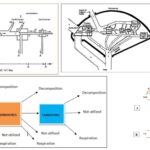IGCSE Biology 57 Views 1 Answers
Sourav PanLv 9November 15, 2024
Explain the adaptive features of sperm, limited to: flagellum, mitochondria and enzymes in the acrosome
Explain the adaptive features of sperm, limited to: flagellum, mitochondria and enzymes in the acrosome
Please login to save the post
Please login to submit an answer.
Sourav PanLv 9May 15, 2025
Sperm cells are highly specialized for their role in reproduction, and they possess several adaptive features that enhance their function. Key adaptations include the flagellum, mitochondria, and enzymes in the acrosome. Here’s a detailed explanation of each feature:
1. Flagellum
- Structure: The flagellum is a long, whip-like tail that extends from the body of the sperm. It is composed of a microtubule-based structure called the axoneme, which is surrounded by a sheath of proteins.
- Function:
- Motility: The primary role of the flagellum is to propel the sperm through the female reproductive tract. It generates movement through a series of coordinated waves or beats, allowing the sperm to swim toward the egg for fertilization.
- Energy Efficiency: The flagellum’s structure allows for efficient movement in an aqueous environment, which is crucial for reaching the egg quickly.
2. Mitochondria
- Structure: Mitochondria are organelles located in the midpiece of the sperm, adjacent to the flagellum. They have a unique morphology adapted for energy production.
- Function:
- Energy Production: Mitochondria are often referred to as the “powerhouses” of the cell because they generate adenosine triphosphate (ATP) through oxidative phosphorylation. This ATP provides the necessary energy for sperm motility, enabling them to swim effectively.
- Metabolic Flexibility: Sperm mitochondria can utilize different substrates (such as fatty acids and glucose) depending on their availability, ensuring that energy production is maintained under varying physiological conditions.
3. Enzymes in the Acrosome
- Structure: The acrosome is a cap-like structure located at the anterior end of the sperm head, derived from the Golgi apparatus during sperm development. It contains various hydrolytic enzymes.
- Function:
- Fertilization Process: Upon reaching the egg, the acrosome undergoes a reaction that releases enzymes such as hyaluronidase and acrosin. These enzymes are crucial for penetrating the zona pellucida, which is a protective glycoprotein layer surrounding the egg.
- Facilitating Fusion: By breaking down this protective layer, these enzymes enable sperm to access and fuse with the egg membrane, thus facilitating successful fertilization.
Summary Table
| Feature | Description | Function |
|---|---|---|
| Flagellum | Long, whip-like tail | Propels sperm through fluid; enables motility toward the egg |
| Mitochondria | Organelles in midpiece | Produces ATP for energy; supports sustained motility |
| Acrosome | Cap-like structure at sperm head | Contains enzymes for penetrating egg’s protective layers; aids fertilization |
0
0 likes
- Share on Facebook
- Share on Twitter
- Share on LinkedIn
0 found this helpful out of 0 votes
Helpful: 0%
Helpful: 0%
Was this page helpful?




